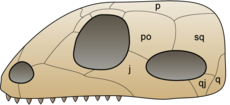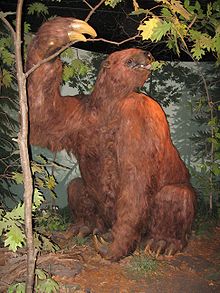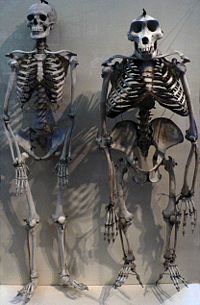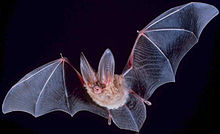- Mammal
-
For other uses, see Mammal (disambiguation).
Mammals
Temporal range: Late Triassic – Recent, 220–0 Ma
Examples of various mammalian orders, click the image and scroll down for individual descriptions Scientific classification 
Kingdom: Animalia Phylum: Chordata Subphylum: Vertebrata Infraphylum: Gnathostomata clade: Eugnathostomata clade: Teleostomi Superclass: Tetrapoda (unranked): Mammaliaformes Class: Mammalia
Linnaeus, 1758Subgroups - Subclass †Allotheria
- Subclass Prototheria
- Subclass Theria
- Infraclass Metatheria
- Infraclass Eutheria
Mammals (formally Mammalia /məˈmeɪli.ə/) are members of a class of air-breathing vertebrate animals characterised by the possession of endothermy, hair, three middle ear bones, and mammary glands functional in mothers with young. Most mammals also possess sweat glands and specialised teeth, and the largest group of mammals, the placentals, have a placenta which feeds the offspring during gestation. The mammalian brain, with its characteristic neocortex, regulates endothermic and circulatory systems, the latter featuring red blood cells lacking nuclei and a large four-chambered heart maintaining the very high metabolism rate they have. Mammals range in size from the 30–40 millimeter (1- to 1.5-inch) Bumblebee Bat to the 33-meter (108-foot) Blue Whale.
The word "mammal" comes from the Latin word "mamma" meaning "breast". All female mammals nurse their young with milk which comes out from special glands called mammary glands. According to Mammal Species of the World, which is updated through periodic editions, 5676 species were known in 2005, distributed in 1,229 genera, 153 families and 29 orders.[1] In 2008 the IUCN completed a 5-year, 17,000 scientist Global Mammal Assessment for its IUCN Red List, which counted 5488 accepted species at the end of that period.[2] The class is divided into two subclasses (not counting fossils): the Prototheria (order of Monotremata) and the Theria, the latter containing the infraclasses Metatheria (including marsupials) and Eutheria (the placentals). The classification of mammals between the relatively stable class and family levels having changed often, different treatments of subclass, infraclass and order appear in contemporaneous literature, especially for Marsupialia.
Except for the five species of monotremes (which lay eggs), all living mammals give birth to live young. Most mammals, including the six most species-rich orders, belong to the placental group. The three largest orders, in descending order, are Rodentia (mice, rats, porcupines, beavers, capybaras, and other gnawing mammals), Chiroptera (bats), and Soricomorpha (shrews, moles and solenodons). The next three largest orders, depending on classification scheme, include the Primates, to which the human species belongs, the Cetartiodactyla (including the even-toed hoofed mammals and the whales) and the Carnivora (dogs, cats, weasels, bears, seals, and their relatives).[1]
The early synapsid mammalian ancestors, a group which included pelycosaurs such as Dimetrodon, diverged from the amniote line that would lead to reptiles at the end of the Carboniferous period. Preceded by many diverse groups of non-mammalian synapsids (sometimes referred to as mammal-like reptiles), the first true mammals appeared 220 million years ago in the Triassic period. Modern mammalian orders appeared in the Palaeocene and Eocene epochs of the Palaeogene period. Phylogenetically, the clade Mammalia is defined as all descendants of the most recent common ancestor of monotremes (e.g., echidnas and platypuses) and therian mammals (marsupials and placentals).[3] This means that some extinct groups of "mammals" are not members of the crown group Mammalia, even though most of them have all the characteristics that traditionally would have classified them as mammals.[4] These "mammals" are now usually placed in the unranked clade Mammaliaformes.
Contents
Distinguishing features
Living mammal species can be identified by the presence of sweat glands, including those that are specialized to produce milk. However, other features are required when classifying fossils, since soft tissue glands and some other features are not visible in fossils. Paleontologists use a distinguishing feature that is shared by all living mammals (including monotremes), but is not present in any of the early Triassic synapsids: mammals use two bones for hearing that were used for eating by their ancestors. The earliest synapsids had a jaw joint composed of the articular (a small bone at the back of the lower jaw) and the quadrate (a small bone at the back of the upper jaw). Most reptiles including lizards, crocodilians, dinosaurs use this system, as did non-mammalian synapsids such as therapsids. Mammals have a different jaw joint, however, composed only of the dentary (the lower jaw bone which carries the teeth) and the squamosal (another small skull bone). In mammals the quadrate and articular bones have become the incus and malleus bones in the middle ear.
Mammals also have a double occipital condyle: they have two knobs at the base of the skull which fit into the topmost neck vertebra, and other vertebrates have a single occipital condyle. Paleontologists use only the jaw joint and middle ear as criteria for identifying fossil mammals, since it would be confusing if they found a fossil that had one feature, but not the other.
Classification
Main article: Mammal classification Over 70% of mammal species are in the orders Rodentia (blue), Chiroptera (red), and Soricomorpha (yellow)
Over 70% of mammal species are in the orders Rodentia (blue), Chiroptera (red), and Soricomorpha (yellow)
George Gaylord Simpson's "Principles of Classification and a Classification of Mammals" (AMNH Bulletin v. 85, 1945) was the original source for the taxonomy listed here. Simpson laid out a systematics of mammal origins and relationships that was universally taught until the end of the 20th century. Since Simpson's classification, the paleontological record has been recalibrated, and the intervening years have seen much debate and progress concerning the theoretical underpinnings of systematization itself, partly through the new concept of cladistics. Though field work gradually made Simpson's classification outdated, it remained the closest thing to an official classification of mammals.
Standardized textbook classification
A somewhat standardized classification system has been adopted by most current mammalogy classroom textbooks. The following taxonomy of extant and recently extinct mammals is from Vaughan et al. (2000).
Class Mammalia
- Subclass Prototheria: monotremes: platypuses and echidnas
- Subclass Theria: live-bearing mammals
- Infraclass Metatheria: marsupials
- Infraclass Eutheria: placentals
McKenna/Bell classification
In 1997, the mammals were comprehensively revised by Malcolm C. McKenna and Susan K. Bell, which has resulted in the "McKenna/Bell classification". Their 1997 book, Classification of Mammals: Above the species level,[4] is the most comprehensive work to date on the systematics, relationships, and occurrences of all mammal taxa, living and extinct, down through the rank of genus. The new McKenna/Bell classification was quickly accepted by paleontologists, though recent molecular genetic data challenge several of the higher level groupings. The authors work together as paleontologists at the American Museum of Natural History, New York. McKenna inherited the project from Simpson and, with Bell, constructed a completely updated hierarchical system, covering living and extinct taxa that reflects the historical genealogy of Mammalia.
The McKenna/Bell hierarchical listing of all of the terms used for mammal groups above the species includes extinct mammals as well as modern groups, and introduces some fine distinctions such as legions and sublegions (ranks which fall between classes and orders) that are likely to be glossed over by the nonprofessionals.
The published re-classification forms both a comprehensive and authoritative record of approved names and classifications and a list of invalid names.
Extinct groups are represented by a dagger (†).
Class Mammalia
- Subclass Prototheria: monotremes: echidnas and the Platypus
- Subclass Theriiformes: live-bearing mammals and their prehistoric relatives
- Infraclass †Allotheria: multituberculates
- Infraclass †Triconodonta: triconodonts
- Infraclass Holotheria: modern live-bearing mammals and their prehistoric relatives
- Supercohort Theria: live-bearing mammals
- Cohort Marsupialia: marsupials
- Magnorder Australidelphia: Australian marsupials and the Monito del Monte
- Magnorder Ameridelphia: New World marsupials
- Cohort Placentalia: placentals
- Magnorder Xenarthra: xenarthrans
- Magnorder Epitheria: epitheres
- Grandorder Anagalida: lagomorphs, rodents, and elephant shrews
- Grandorder Ferae: carnivorans, pangolins, †creodonts, and relatives
- Grandorder Lipotyphla: insectivorans
- Grandorder Archonta: bats, primates, colugos, and treeshrews
- Grandorder Ungulata: ungulates
- Order Tubulidentata incertae sedis: aardvark
- Mirorder Eparctocyona: †condylarths, whales, and artiodactyls (even-toed ungulates)
- Mirorder †Meridiungulata: South American ungulates
- Mirorder Altungulata: perissodactyls (odd-toed ungulates), elephants, manatees, and hyraxes
- Cohort Marsupialia: marsupials
- Supercohort Theria: live-bearing mammals
Molecular classification of placentals
Molecular studies based on DNA analysis have suggested new relationships among mammal families over the last few years. Most of these findings have been independently validated by retrotransposon presence/absence data. The most recent classification systems based on molecular studies have proposed four groups or lineages of placental mammals. Molecular clocks suggest that these clades diverged from early common ancestors in the Cretaceous, but fossils have not yet been found to corroborate this hypothesis. These molecular findings are consistent with mammal zoogeography:
Following molecular DNA sequence analyses, the first divergence was that of the Afrotheria 110–100 million years ago. The Afrotheria proceeded to evolve and diversify in the isolation of the African-Arabian continent. The Xenarthra, isolated in South America, diverged from the Boreoeutheria approximately 100–95 million years ago. According to an alternative view, the Xenarthra has the Afrotheria as closest allies, forming the Atlantogenata as sistergroup to Boreoeutheria. The Boreoeutheria split into the Laurasiatheria and Euarchontoglires between 95 and 85 mya; both of these groups evolved on the northern continent of Laurasia. After tens of millions of years of relative isolation, Africa-Arabia collided with Eurasia, exchanging Afrotheria and Boreoeutheria. The formation of the Isthmus of Panama linked South America and North America, which facilitated the exchange of mammal species in the Great American Interchange. The traditional view that no placental mammals reached Australasia until about 5 million years ago when bats and murine rodents arrived has been challenged by recent evidence and may need to be reassessed. These molecular results are still controversial because they are not reflected by morphological data, and thus not accepted by many systematists. Further there is some indication from retrotransposon presence/absence data that the traditional Epitheria hypothesis, suggesting Xenarthra as the first divergence, might be true. With the old order Insectivora shown to be polyphylectic and more properly subdivided (as Afrosoricida, Erinaceomorpha, and Soricomorpha), the following classification for placental mammals contains 21 orders:
- Clade Atlantogenata
- Group I: Afrotheria
- Clade Afroinsectiphilia
- Order Macroscelidea: elephant shrews (Africa)
- Order Afrosoricida: tenrecs and golden moles (Africa)
- Order Tubulidentata: aardvark (Africa south of the Sahara)
- Clade Paenungulata
- Order Hyracoidea: hyraxes or dassies (Africa, Arabia)
- Order Proboscidea: elephants (Africa, Southeast Asia)
- Order Sirenia: dugong and manatees (cosmopolitan tropical)
- Clade Afroinsectiphilia
- Group II: Xenarthra
- Group I: Afrotheria
- Clade Boreoeutheria
- Group III: Euarchontoglires (Supraprimates)
- Superorder Euarchonta
- Order Scandentia: treeshrews (Southeast Asia).
- Order Dermoptera: flying lemurs or colugos (Southeast Asia)
- Order Primates: lemurs, bushbabies, monkeys, apes, human (cosmopolitan)
- Superorder Glires
- Order Lagomorpha: pikas, rabbits, hares (Eurasia, Africa, Americas)
- Order Rodentia: rodents (cosmopolitan)
- Superorder Euarchonta
- Group IV: Laurasiatheria
- Order Erinaceomorpha: hedgehogs
- Order Soricomorpha: moles, shrews, solenodons
- Clade Ferungulata
- Clade Cetartiodactyla
- Clade Pegasoferae
- Group III: Euarchontoglires (Supraprimates)
Evolutionary history
For more details on this topic, see Evolution of mammals.Mammaliaformes void Sinocodon
void void void ––Mammalia
Synapsida, the group which contains mammals and their extinct relatives, originated during the Pennsylvanian epoch, when they split from the lineage that led to reptiles and birds. Non-mammalian synapsids were once called "mammal-like reptiles", although they are usually no longer considered reptiles. Mammals evolved from non-mammalian synapsids during the Early Jurassic.
Evolution from amniotes in the Paleozoic
The first fully terrestrial vertebrates were amniotes. Like their amphibian predecessors, they have lungs and limbs. Amniotes' eggs, however, have internal membranes which allow the developing embryo to breathe but keep water in. Hence amniotes can lay eggs on dry land, while amphibians generally need to lay their eggs in water.
The first amniotes apparently arose in the late Carboniferous. They descended from earlier reptiliomorph amphibians,[5] which lived on land already inhabited by insects and other invertebrates, and by ferns, mosses and other plants. Within a few million years two important amniote lineages became distinct: the synapsids, which include mammals; and the sauropsids, which include lizards, snakes, crocodilians, dinosaurs and birds.[6] Synapsids have a single hole (temporal fenestra) low on each side of the skull.
One synapsid group, the pelycosaurs, were the most common land vertebrates of the early Permian and included the largest land animals of the time.[7]
Therapsids descended from pelycosaurs in the middle Permian, about 260M years ago, and took over their position as the dominant land vertebrates. They differ from pelycosaurs in several features of the skull and jaws, including: larger temporal fenestrae and incisors which are equal in size.[8] The therapsids went through a series of stages, beginning with animals which were very like their pelycosaur ancestors and ending with the Triassic cynodonts, some of which could easily be mistaken for mammals. Those stages were characterized by:
- gradual development of a bony secondary palate.[9]
- progress towards an erect limb posture, which would increase the animals' stamina by avoiding Carrier's constraint. But this process was slow and erratic – for example: all herbivorous non-mammaliaform therapsids retained sprawling limbs (some late forms may have had semi-erect hind limbs); Permian carnivorous therapsids had sprawling forelimbs, and some late Permian ones also had semi-sprawling hindlimbs. In fact modern monotremes still have semi-sprawling limbs.
- the dentary gradually becoming the main bone of the lower jaw; and in the Triassic, progress towards the fully mammalian jaw (the lower consisting only of the dentary) and middle ear (which is constructed by the bones that were previously used to construct the jaws of Reptiles)
- there is possible evidence of hair in Triassic therapsids, but none for Permian therapsids.
- some scientists have argued that some Triassic therapsids show signs of lactation.
True mammals evolve in the Triassic
The Permian–Triassic extinction event, which was a prolonged event due to the accumulation of several extinction pulses, ended the dominance of the therapsids. In the Early Triassic all the medium to large land animal niches were taken over by early archosaurs, which over an extended period of time (35 million years) evolved into crocodilians, pterosaurs, dinosaurs and birds. After this "Triassic Takeover" the cynodonts and their descendants could only survive as small, mainly nocturnal insectivores.[10]
The first true mammals appeared in the Late Triassic (ca. 200 million years ago), over 70 million years after the first therapsids and approximately 30 million years after the first mammaliaformes. The rat-like Hadrocodium appears to be in the middle of the transition to true mammal status — it had a mammalian jaw joint (formed by the dentary and squamosal bones), but there is some debate about whether its middle ear was fully mammalian.[11] The majority of the mammal species that existed in the Mesozoic Era were characterized by Multituberculates.
The earliest known monotreme is Teinolophos, which lived about 123M years ago in Australia. Monotremes have some features which may be inherited from the original amniotes:
- they use the same orifice to urinate, defecate and reproduce ("monotreme" means "one hole") – as lizards and birds also do.
- they lay eggs which are leathery and uncalcified, like those of lizards, turtles and crocodilians.
Unlike other mammals, female monotremes do not have nipples and feed their young by "sweating" milk from patches on their bellies.
The oldest known marsupial is Sinodelphys, found in 125M-year old early Cretaceous shale in China's northeastern Liaoning Province. The fossil is nearly complete and includes tufts of fur and imprints of soft tissues.[12]
Reconstruction based on Megalonyx jeffersonii, Iowa Museum of Natural History, University of Iowa
The living Eutheria ("true beasts") are all placentals. An early eutherian, Eomaia, found in China and dated to 125M years ago, obtained some features which are more like those of marsupials, which suggested it was perhaps a transitional fossil that eventually gave rise to the placental lineage (the surviving metatherians):[13]
- Epipubic bones extending forwards from the pelvis, which are not found in any modern placental, but are found in marsupials, monotremes and mammaliformes such as multituberculates. In other words, they appear to be an ancestral feature which subsequently disappeared in the placental lineage. These epipubic bones seem to function by stiffening the muscles of these animals during locomotion, reducing the amount of space being presented, which placentals require to contain their fetus during gestation periods.
- A narrow pelvic outlet, which indicates that the young were very small at birth and therefore pregnancy was short, as in modern marsupials. This suggests that the placenta was a later development.
Now the discovery of a partial skeleton of a small, shrewlike mammal, described online in Nature in August of 2011, pushes back the date of the divergence by 30 million years, to 160 million years ago. Found in the famous fossil beds of Liaoning, China, the newly discovered little mammal has been named Juramaia sinensis, or "Jurassic mother from China."
It is not certain when true placental mammals evolved – the earliest undisputed fossils of placentals come from the early Paleocene, after the extinction of the dinosaurs.[14]
Mammals and near-mammals expanded out of their nocturnal insectivore niche from the mid Jurassic onwards – for example Castorocauda had adaptations for swimming, digging and catching fish.[15]
Rise to dominance in the Cenozoic
Mammals took over the medium- to large-sized ecological niches in the Cenozoic, after the Cretaceous–Tertiary extinction event emptied ecological space once filled by reptiles.[16] Then mammals diversified very quickly, both birds and mammals show an exponential rise in diversity.[16] An example is that the earliest known bat dates from about 50M years ago, only 15M years after the extinction of the dinosaurs.[17]
Recent molecular phylogenetic studies suggest that most placental orders diverged about 100M to 85M years ago, but that modern families first appeared in the late Eocene and early Miocene[18] But paleontologists object that no placental fossils have been found from before the end of the Cretaceous.[14]
During the Cenozoic several groups of mammals appeared which were much larger than their nearest modern equivalents – but none was even close to the size of the largest dinosaurs with similar feeding habits.
Earliest appearances of features
Hadrocodium, whose fossils date from the early Jurassic (approx. 195 million years ago), provides the first clear evidence of fully mammalian jaw joints.
It has been suggested that the original function of lactation (milk production) was to keep eggs moist. Much of the argument is based on monotremes (egg-laying mammals).[19][20][21]
The earliest clear evidence of hair or fur is in fossils of Castorocauda, from 164M years ago in the mid Jurassic. From 1955 onwards some scientists have interpreted the foramina (passages) in the maxillae (upper jaws) and premaxillae (small bones in front of the maxillae) of cynodonts as channels which supplied blood vessels and nerves to vibrissae (whiskers), and suggested that this was evidence of hair or fur.[22][23] But foramina do not necessarily show that an animal had vibrissae – for example the modern lizard Tupinambis has foramina which are almost identical to those found in the non-mammalian cynodont Thrinaxodon.[24][25]
 American Lion was one of the abundant Pleistocene megafauna, a wide variety of very large mammals that lived during the Pleistocene and went extinct about 10,000 years ago.[26]
American Lion was one of the abundant Pleistocene megafauna, a wide variety of very large mammals that lived during the Pleistocene and went extinct about 10,000 years ago.[26]
The evolution of erect limbs in mammals is incomplete — living and fossil monotremes have sprawling limbs. In fact some scientists think that the parasagittal (non-sprawling) limb posture is a synapomorphy (distinguishing characteristic) of the Boreosphenida, a group which contains the Theria and therefore includes the last common ancestor of modern marsupial and placentals – and therefore that all earlier mammals had sprawling limbs.[27] Sinodelphys (the earliest known marsupial) and Eomaia (the earliest known eutherian) lived about 125M years ago, so erect limbs must have evolved before then.
It is currently very difficult to be confident when endothermy first appeared in the evolution of mammals. Modern monotremes have a lower body temperature and more variable metabolic rate than marsupials and placentals.[28] So the main question is when a monotreme-like metabolism evolved in mammals. The evidence found so far suggests Triassic cynodonts may have had fairly high metabolic rates, but is not conclusive. In particular it is difficult to see how small animals can maintain a high and stable body temperature without fur.
Anatomy and morphology
Skeletal system
The majority of mammals have seven cervical vertebrae (bones in the neck); this includes bats, giraffes, whales, and humans. The few exceptions include the manatee and the two-toed sloth, which have only six cervical vertebrae, and the three-toed sloth with nine cervical vertebrae.[29]
Respiratory system
The lungs of mammals have a spongy texture and are honeycombed with epithelium having a much larger surface area in total than the outer surface area of the lung itself. The lungs of humans are typical of this type of lung.
Breathing is largely driven by the muscular diaphragm which divides the thorax from the abdominal cavity, forming a dome with its convexity towards the thorax. Contraction of the diaphragm flattens the dome increasing the volume of the cavity in which the lung is enclosed. Air enters through the oral and nasal cavities; it flows through the larynx, trachea and bronchi and expands the alveoli. Relaxation of the diaphragm has the opposite effect, passively recoiling during normal breathing. During exercise, the abdominal wall contracts, increasing visceral pressure on the diaphragm, thus forcing the air out more quickly and forcefully. The rib cage itself also is able to expand and contract the thoracic cavity to some degree, through the action of other respiratory and accessory respiratory muscles. As a result, air is sucked into or expelled out of the lungs, always moving down its pressure gradient. This type of lung is known as a bellows lung as it resembles a blacksmith's bellows. Mammals take oxygen into their lungs, and discard carbon dioxide.
Nervous system
All mammalian brains possess a neocortex, a brain region that is unique to mammals. Placental mammals have a corpus callosum unlike monotremes and marsupials. The size and number of cortical areas (Brodmann's areas) is least in monotremes (about 8-10) and most in placentals (up to 50).
Integumentary system
The integumentary system is made up of three layers: the outermost epidermis, the dermis, and the hypodermis.
The epidermis is typically ten to thirty cells thick, its main function being to provide a waterproof layer. Its outermost cells are constantly lost; its bottommost cells are constantly dividing and pushing upward. The middle layer, the dermis, is fifteen to forty times thicker than the epidermis. The dermis is made up of many components such as bony structures and blood vessels. The hypodermis is made up of adipose tissue. Its job is to store lipids, and to provide cushioning and insulation. The thickness of this layer varies widely from species to species.
Although mammals and other animals have cilia that superficially may resemble it, no other animals except mammals have hair. It is a definitive characteristic of the class. Some mammals have very little, but nonetheless, careful examination reveals the characteristic, often in obscure parts of their bodies. None are known to have hair that naturally is blue or green in color[citation needed] although some cetaceans, along with the mandrills, appear to have shades of blue skin. Many mammals are indicated as having blue hair or fur, but in all known cases, it has been found to be a shade of gray. The two-toed sloth and the polar bear may seem to have green fur, but this color is caused by algae growths.
Reproductive system
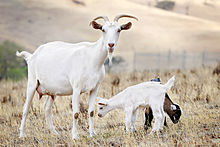 Goat kids will stay with their mother until they are weaned.
Goat kids will stay with their mother until they are weaned.
Most mammals give birth to live young (vivipary), but a few, namely the monotremes, lay eggs. The platypus and the echidna present a particular sex determination system that is different from other vertebrates.[30]
Certain glands of mammals known as mammary glands are specialized to produce milk, a liquid used by newborns as their primary source of nutrition. The monotremes branched early from other mammals and do not have the nipples seen in most mammals, but they do have mammary glands.
Viviparous mammals are classified into the subclass Theria and are divided into two infraclasses: Metatheria (of which only the Marsupialia survive), and Eutheria. Marsupialia, or marsupials, have short gestation periods and give birth to undeveloped young which are contained within a pouch-like sac (marsupium) located in front of the mothers' abdomen. Eutherians, commonly known as placentals, are mammals that give birth to complete and fully developed young. This is usually characterized by long gestation periods. The majority of mammal species are classified as eutherians.
Physiology
Endothermy
Nearly all mammals are endothermic ("warm-blooded"). Most mammals also have hair to help keep them warm. Like birds, mammals can forage or hunt in cold weather and climates where non-avian reptiles and large insects cannot.
Endothermy requires plenty of food energy, so pound for pound mammals eat more food than most reptiles. Small insectivorous mammals eat prodigious amounts for their size.
A rare exception, the naked mole rat produces little metabolic heat, so it is considered an operational poikilotherm. Birds are also endothermic, so endothermy is not a defining mammalian feature.
Intelligence
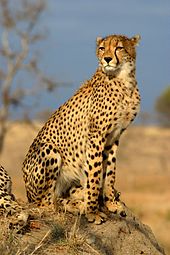 The fastest land animal, the cheetah can reach 120 kmh (75 mph)
The fastest land animal, the cheetah can reach 120 kmh (75 mph)
In intelligent mammals, such as primates, the cerebrum is larger relative to the rest of the brain. Intelligence itself is not easy to define, but indications of intelligence include the ability to learn, matched with behavioral flexibility. Rats, for example, are considered to be highly intelligent as they can learn and perform new tasks, an ability that may be important when they first colonize a fresh habitat. In some mammals, food gathering appears to be related to intelligence: a deer feeding on plants has a brain smaller than a cat, which must think to outwit its prey.[31]
Social structure
Locomotion
See also: Animal locomotionMammals evolved from four-legged ancestors. They use their limbs to walk, climb, swim, and fly. Some land mammals have toes that produce claws and hooves for climbing and running. Aquatic mammals such as whales and dolphins have flippers which evolved from legs.
Terrestrial
See also: Terrestrial locomotionArboreal
See also: Arboreal locomotionSloths travel slowly along branches rather than swinging energetically like monkeys.
Aquatic
Buoyed by their aquatic environment, whales have evolved into the largest mammals and indeed the largest animals ever.
Aerial
See also: Aerial locomotionFeeding
To maintain a high constant body temperature is energy expensive – mammals therefore need a nutritious and plentiful diet. While the earliest mammals were probably predators, different species have since adapted to meet their dietary requirements in a variety of ways. Some eat other animals – this is a carnivorous diet (and includes insectivorous diets). Other mammals, called herbivores, eat plants. A herbivorous diet includes sub-types such as fruit-eating and grass-eating. An omnivore eats both prey and plants. Carnivorous mammals have a simple digestive tract, because the proteins, lipids, and minerals found in meat require little in the way of specialized digestion. Plants, on the other hand, contain complex carbohydrates, such as cellulose. The digestive tract of an herbivore is therefore host to bacteria that ferment these substances, and make them available for digestion. The bacteria are either housed in the multi-chambered stomach or in a large cecum. The size of an animal is also a factor in determining diet type. Since small mammals have a high ratio of heat-losing surface area to heat-generating volume, they tend to have high-energy requirements and a high metabolic rate. Mammals that weigh less than about 18 oz (500 g) are mostly insectivorous because they cannot tolerate the slow, complex digestive process of a herbivore. Larger animals on the other hand generate more heat and less of this heat is lost. They can therefore tolerate either a slower collection process (those that prey on larger vertebrates) or a slower digestive process (herbivores). Furthermore, mammals that weigh more than 18 oz (500 g) usually cannot collect enough insects during their waking hours to sustain themselves. The only large insectivorous mammals are those that feed on huge colonies of insects (ants or termites).[31]
Specializations in herbivory include: Granivory "seed eating", folivory "leaf eating", fruivory "fruit eating", nectivory "nectar eating", gumivory "gum eating", and mycophagy "fungus eating".
See also
- List of African mammals
- List of extinct mammals
- List of Indian mammals
- List of mammalogists
- List of mammal genera
- List of mammals
- Lists of mammals by region
- List of prehistoric mammals
- Mammal classification
- Mammals discovered in the 2000s
- Prehistoric mammals
References
- ^ a b Wilson, Don E.; Reeder, DeeAnn M., eds (2005). "Preface and introductory material". Mammal Species of the World (3rd ed.). Baltimore: Johns Hopkins University Press, 2 vols. (2142 pp.). p. xxvi. ISBN 978-0-8018-8221-0. OCLC 62265494. http://www.bucknell.edu/msw3.
- ^ "Initiatives". The IUCN Red List of Threatened Species. IUCN. April, 2010. http://www.iucnredlist.org/initiatives.
- ^ Rose, Kenneth D. (2006). The beginning of the age of mammals. Baltimore: Johns Hopkins University Press. p. 43. ISBN 0-8018-8472-1.
- ^ a b McKenna, Malcolm C.; Bell, Susan Groag (1997). Classification of Mammals. Columbia University Press. p. 32. ISBN 0-231-11013-8.
- ^ Ahlberg, P. E. and Milner, A. R. (April 1994). "The Origin and Early Diversification of Tetrapods". Nature 368 (6471): 507–514. Bibcode 1994Natur.368..507A. doi:10.1038/368507a0. http://www.nature.com/nature/journal/v368/n6471/abs/368507a0.html. Retrieved 2008-09-06.
- ^ "Amniota – Palaeos". http://www.palaeos.org/Amniota.
- ^ "Synapsida overview – Palaeos". http://www.palaeos.com/Vertebrates/Units/Unit390/000.html.
- ^ "Therapsida – Palaeos". http://www.palaeos.com/Vertebrates/Units/400Therapsida/100.html.
- ^ Kermack, D.M.; Kermack, K.A. (1984). The evolution of mammalian characters. Croom Helm. ISBN 079915349.
- ^ "Cynodontia: Overview – Palaeos". http://www.palaeos.com/Vertebrates/Units/410Cynodontia/410.000.html.
- ^ "Symmetrodonta – Palaeos". http://www.palaeos.com/Vertebrates/Units/Unit420/420.300.html.
- ^ "Oldest Marsupial Fossil Found in China". National Geographic News. December 15, 2003. http://news.nationalgeographic.com/news/2003/12/1215_031215_oldestmarsupial.html.
- ^ "Eomaia scansoria: discovery of oldest known placental mammal". http://www.evolutionpages.com/Eomaia%20scansoria.htm.
- ^ a b "Dinosaur Extinction Spurred Rise of Modern Mammals". News.nationalgeographic.com. http://news.nationalgeographic.com/news/2007/06/070620-mammals-dinos.html. Retrieved 2009-03-08.
- ^ "Jurassic "Beaver" Found; Rewrites History of Mammals". http://news.nationalgeographic.com/news/2006/02/0223_060223_beaver.html.
- ^ a b Sahney, S., Benton, M.J. and Ferry, P.A. (2010). "Links between global taxonomic diversity, ecological diversity and the expansion of vertebrates on land" (PDF). Biology Letters 6 (4): 544–547. doi:10.1098/rsbl.2009.1024. PMC 2936204. PMID 20106856. http://rsbl.royalsocietypublishing.org/content/6/4/544.full.pdf+html.
- ^ "Rogue finger gene got bats airborne". Newscientist.com. http://www.newscientist.com/news/news.jsp?id=ns99996647. Retrieved 2009-03-08.
- ^ Bininda-Emonds, O.R.P.; Cardillo, M.; Jones, K.E.; 'et al.', Ross D. E.; Beck, Robin M. D.; Grenyer, Richard; Price, Samantha A.; Vos, Rutger A. et al. (2007). "The delayed rise of present-day mammals". Nature 446 (7135): 507–511. Bibcode 2007Natur.446..507B. doi:10.1038/nature05634. PMID 17392779. http://scienceblogs.com/pharyngula/2007/03/dont_blame_the_dinosaurs.php.
- ^ Oftedal, O.T. (2002). "The mammary gland and its origin during synapsid evolution". Journal of Mammary Gland Biology and Neoplasia 7 (3): 225–252. doi:10.1023/A:1022896515287. PMID 12751889.
- ^ Oftedal, O.T. (2002). "The origin of lactation as a water source for parchment-shelled eggs". Journal of Mammary Gland Biology and Neoplasia 7 (3): 253–266. doi:10.1023/A:1022848632125. PMID 12751890.
- ^ "Lactating on Eggs". Nationalzoo.si.edu. 2003-07-14. http://nationalzoo.si.edu/ConservationAndScience/SpotlightOnScience/oftedalolav20030714.cfm. Retrieved 2009-03-08.
- ^ Brink, A.S. (1955). "A study on the skeleton of Diademodon". Palaeontologia Africana 3: 3–39.
- ^ Kemp, T.S. (1982). Mammal-like reptiles and the origin of mammals. London: Academic Press. p. 363. ISBN 0124041205.
- ^ Bennett, A. F. and Ruben, J. A. (1986) "The metabolic and thermoregulatory status of therapsids"; pp. 207–218 in N. Hotton III, P. D. MacLean, J. J. Roth and E. C. Roth (eds), "The ecology and biology of mammal-like reptiles", Smithsonian Institution Press, Washington.
- ^ Estes, R. (1961). "Cranial anatomy of the cynodont reptile Thrinaxodon liorhinus". Bulletin of the Museum of Comparative Zoology (1253): 165–180.
- ^ Ice Age Animals, Illinois State Museum
- ^ Kielan−Jaworowska, Z.; Hurum, J.H.. (2006). "Limb posture in early mammals: Sprawling or parasagittal" (–Scholar search). Acta Palaeontologica Polonica 51 (3): 10237–10239. http://www.app.pan.pl/acta51/app51-393.pdf.[dead link]
- ^ Paul, G.S. (1988). Predatory Dinosaurs of the World. New York: Simon and Schuster. p. 464. ISBN 0671619462.
- ^ Google Books
- ^ Wallis, M.C., Waters, P.D., Delbridge, M.L., Kirby, P.J., Pask, A.J., Grützner, F., Rens, W., Ferguson-Smith, M.A., and Graves, J.A.M. (December 2007). Sex determination in platypus and echidna: autosomal location of SOX3 confirms the absence of SRY from monotremes. Chromosome Research 15(8): 949–959. ISSN 0967-3849 (Print) 1573–6849 (Online). doi:10.1007/s10577-007-1185-3.
- ^ a b Don E. Wilson & David Burnie, ed (2001). Animal: The Definitive Visual Guide to the World's Wildlife (1st ed.). DK Publishing. pp. 86–89. ISBN 978-0789477644.
Further reading
- Bergsten, Johannes. February 2005. "A review of long-branch attraction". Cladistics 21:163–193. (pdf version)
- Brown W.M. (2001). "Natural selection of mammalian brain components" (PDF). Trends in Ecology and Evolution 16 (9): 471–473. doi:10.1016/S0169-5347(01)02246-7. http://www.rci.rutgers.edu/~wmbrown/BROWN.TREE.pdf.
- Khalaf-von Jaffa, Norman Ali Bassam Ali Taher (2006). Mammalia Palaestina: The Mammals of Palestine. Gazelle: The Palestinian Biological Bulletin. Number 55, July 2006. pp. 1–46.
- McKenna, Malcolm C., and Bell, Susan K. 1997. Classification of Mammals Above the Species Level. Columbia University Press, New York, 631 pp. ISBN 0-231-11013-8
- Nowak, Ronald M. 1999. Walker's Mammals of the World, 6th edition. Johns Hopkins University Press, 1936 pp. ISBN 0-8018-5789-9
- Simpson, George Gaylord (1945). "The principles of classification and a classification of mammals". Bulletin of the American Museum of Natural History 85: 1–350.
- William J. Murphy, Eduardo Eizirik, Mark S. Springer et al., Resolution of the Early Placental Mammal Radiation Using Bayesian Phylogenetics,Science, Vol 294, Issue 5550, 2348–2351, 14 December 2001.
- Springer, Mark S., Michael J. Stanhope, Ole Madsen, and Wilfried W. de Jong. 2004. "Molecules consolidate the placental mammal tree". Trends in Ecology and Evolution, 19:430–438. (PDF version)
- Vaughan, Terry A., James M. Ryan, and Nicholas J. Capzaplewski. 2000. Mammalogy: Fourth Edition. Saunders College Publishing, 565 pp. ISBN 0-03-025034-X (Brooks Cole, 1999)
- Jan Ole Kriegs, Gennady Churakov, Martin Kiefmann, Ursula Jordan, Juergen Brosius, Juergen Schmitz. (2006) Retroposed Elements as Archives for the Evolutionary History of Placental Mammals. PLoS Biol 4(4): e91."PLoS Biology – Retroposed Elements as Archives for the Evolutionary History of Placental Mammals". Biology.plosjournals.org. doi:10.1371/journal.pbio.0040091. http://biology.plosjournals.org/perlserv/?request=get-document&doi=10.1371/journal.pbio.0040091. Retrieved 2009-03-08.
- David MacDonald, Sasha Norris. 2006. The Encyclopedia of Mammals, 3rd edition. Printed in China, 930 pp. ISBN 0-681-45659-0.
External links
External identifiers for Mammalia EOL 1642 ITIS 179913 NCBI 40674 uBio NameBank 2478620 Also found in: Wikispecies, Arctos - BBC Wildlife Finder – video clips from the BBC's natural history archive
- GlobalTwitcher.com – All species in the world with distribution maps and images
- Paleocene Mammals, a site covering the rise of the mammals, paleocene-mammals.de
- Evolution of Mammals, a brief introduction to early mammals, enchantedlearning.com
- Tree of Life poster – Shows mammals' evolutionary relation to other organisms, tellapallet.com
- The Evolution of Mesozoic Mammals, a Rough Sketch, an informal introduction, home.arcor.de
- Carnegie Museum of Natural History, some discoveries of early mammal fossils, carnegiemnh.org
- High-Resolution Images of various Mammalian Brains, brainmaps.org
- Mammal Species, collection of information sheets about various mammal species, learnanimals.com
- Summary of molecular support for Epitheria, biology.plosjournals.org
- Mikko's Phylogeny Archive, fmnh.helsinki.fi
- European Mammal Atlas EMMA from Societas Europaea Mammalogica, European-mammals.org
- Marine Mammals of the World—An overview of all marine mammals, including descriptions, multimedia and a key, eti.uva.nl
- Mammalogy.org The American Society of Mammalogists was established in 1919 for the purpose of promoting the study of mammals, and this website includes a mammal image library
Extant Chordata classes by subphylum Urochordata (Tunicates) Cephalochordata (Lancelets) Craniata Extant mammal orders by infraclass Australosphenida Metatheria
(Marsupial inclusive)Eutheria
(Placental inclusive)Categories:- Mammals
Wikimedia Foundation. 2010.

